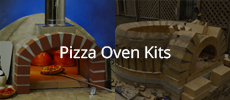We inherited a wood fired oven built straight into the wall of our dining room when we bought our house ... the only catch is that previous owners had built a stud wall in front of the opening to cover it up and removed the chimney. Finally got around to removing the wall and rebuilding the chimney this year, but now I have questions. Any insight would be appreciated.
Ash Dump
The oven has a slot at the opening that serves as an ash dump to an enclosed cinder block base that can be emptied from outside. The only issue is that the slot is inside the door which seems problematic for cooking with retained heat. I know a bit about the history of the oven and the people who built it seem to have known what they were doing (seems similar to an Alan Scott vault design) but this seems like an odd choice. Is there a reason for this? Do I need to come up with some sort of cover to avoid heat escaping through the slot into the less insulated ash chamber?
Repointing Mortar Joints
The oven has been boarded up for 20 years (and largely out of use for 30) though it has sat under a couple layers of metal roofing the whole time. It looks to be in fairly good condition, but there are decent gaps between some of the bricks on the ceiling of the oven in particular. Is this something I should be repointing to seal up the oven?
Small Vent in Back
This one is more of just a curiosity, but there appears to be a small pipe in the back of the oven with some sort of wire hanging out of it. Curious if anyone has any idea what its purpose is.
I've fired up the oven a few times with decent results -- didn't get it hot enough for pizza, though it's fairly large so maybe just needed more fuel, and it didn't retain heat well, possibly due to the ash dump. Looking to fine tune it a bit (and make sure it's really safe to use after being dormant all these years.




Ash Dump
The oven has a slot at the opening that serves as an ash dump to an enclosed cinder block base that can be emptied from outside. The only issue is that the slot is inside the door which seems problematic for cooking with retained heat. I know a bit about the history of the oven and the people who built it seem to have known what they were doing (seems similar to an Alan Scott vault design) but this seems like an odd choice. Is there a reason for this? Do I need to come up with some sort of cover to avoid heat escaping through the slot into the less insulated ash chamber?
Repointing Mortar Joints
The oven has been boarded up for 20 years (and largely out of use for 30) though it has sat under a couple layers of metal roofing the whole time. It looks to be in fairly good condition, but there are decent gaps between some of the bricks on the ceiling of the oven in particular. Is this something I should be repointing to seal up the oven?
Small Vent in Back
This one is more of just a curiosity, but there appears to be a small pipe in the back of the oven with some sort of wire hanging out of it. Curious if anyone has any idea what its purpose is.
I've fired up the oven a few times with decent results -- didn't get it hot enough for pizza, though it's fairly large so maybe just needed more fuel, and it didn't retain heat well, possibly due to the ash dump. Looking to fine tune it a bit (and make sure it's really safe to use after being dormant all these years.






Comment